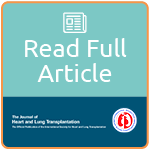“Outcomes of children supported with devices labeled as “temporary” or short term: A report from the Pediatric Interagency Registry for Mechanical Circulatory Support” was published in The Journal of Heart and Lung Transplantation on Oct 31, 2017. When this report was published, the use of “temporary” VADs had expanded to include bridge to transplant, bridge to decision, and destination therapy; these devices were originally used only as a quick bridge to recovery in children. The use of longer term temporary VAD support in children continues to evolve, as researchers learn more and more from important reports like this one.
What did we learn from this PediMACS report? Importantly, it described the overall use, characteristics, and outcomes of “temporary” VAD use in a multi-institutional, high-acuity, complex patient cohort of 63 children implanted between 9/2012 – 6/2016. The results? 71% of patients experienced a positive outcome: “(defined as bridge to recovery [30%], transplantation [17%], alive on device [2%] or transition to durable VAD [22%]), and 88% of the cardiomyopathy patients and 60% of the single-ventricle patients achieved a favorable outcome.”
Researchers included four ACTION leaders/members:
- Mary Mehegan, St. Louis Children’s Hospital
- Angela Lorts, Chet Villa, and David Morales, Cincinnati Children’s Hospital Medical Center
CITATION
Lorts A, Eghtesady P, Mehegan M, Adachi I, Villa C, Davies R, Gossett JG, Kanter K, Alejos J, Koehl D, Cantor RS, Morales DLS. Outcomes of children supported with devices labeled as “temporary” or short term: A report from the Pediatric Interagency Registry for Mechanical Circulatory Support. J Heart Lung Transplant. 2018 Jan;37(1):54-60. doi: 10.1016/j.healun.2017.10.023. Epub 2017 Oct 31. PMID: 29174220.

